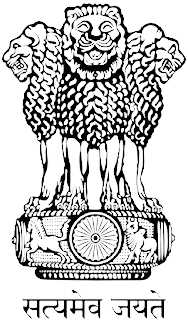STATE EMBLEM OF BHARAT (INDIA)

STATE EMBLEM OF BHARAT (INDIA) The State Emblem of Bharat (India) is an adaptation from the Sarnath Lion Capital of Asoka which is preserved in the Sarnath Museum. The Lion Capital has four lions mounted back to back on a circular abacus. The frieze of the abacus is adorned with sculptures in high relief of an elephant, a galloping horse, a bull and a lion separated by intervening Dharma Chakras. The abacus rests on a bell-shaped lotus. The profile of the Lion Capital showing three lions mounted on the abacus with a Dharma Chakra in the center, a bull on the right and a galloping horse on the left and outlines of Dharma Chakras on the extreme right and left has been adopted as the State Emblem of India. The Bell-shaped lotus has been omitted. The motto ‘Satyameva Jayate’ - 'Truth alone triumphs' written in Devanagari script below the profile of the Lion Capital is part of the State Emblem of Bharat. The government adopted the emblem on January 26, 1950, the day when India...